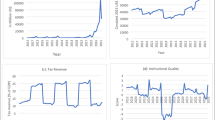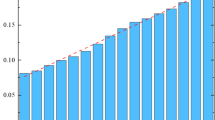Abstract
Can artificial intelligence (AI) algorithms help policymakers in their decisions on inclusive growth? In this study, we introduce artificial intelligence algorithms to calibrate China's inclusive growth determinants. We uncover various factors that significantly influence inclusive growth using machine learning forecasts. Furthermore, our results using best practice methods outperform findings from traditional regression-based strategies on other dimensions, which miss non-linear interactions in their estimations. However, we observe that when the actual value of the inclusive growth index is too large, the accuracy of the machine learning model is diminished. Meanwhile, the results of heterogeneity analysis reveal that the determinants of inclusive growth in cities with different region and different marketization level are distinct. In addition, we adopt the scenario simulation and prediction approach to reveal the best policy measure to promote inclusive growth in China. Our findings indicate that machine learning holds promise for understanding how inclusive growth can be achieved and can assist real-world economies in enhancing inclusive growth.










Similar content being viewed by others
Data Availability
The datasets used and/or analyzed during the current study are available from the corresponding author on reasonable request.
References
Ahmad, S., Oliveira, P. D., et al. (2016). Determinants of urban mobility in India: Lessons for promoting sustainable and inclusive urban transportation in developing countries. Transport Policy, 50, 1060–1114. https://doi.org/10.1016/j.tranpol.2016.04.014
Akbari, A., Ng, L., & Solnik, B. (2021). Drivers of economic and financial integration: A machine learning approach. Journal of Empirical Finance, 61, 82–102.
Angelopulo, G. (2021). A comparative measure of inclusive urbanisation in the cities of Africa. World Development Perspectives, 22, 100313.
Bao, W., Lianju, N., & Yue, K. (2019). Integration of unsupervised and supervised machine learning algorithms for credit risk assessment. Expert Systems with Applications, 128, 301–315. https://doi.org/10.1016/j.eswa.2019.02.033
Boikos, S., Panagiotidis, T., & Voucharas, G. (2021). Financial development, reforms and growth. Economic Modelling. https://doi.org/10.1016/J.ECONMOD.2021.105734
Bollaert, H., Lopez-de-Silanes, F., & Schwienbacher, A. (2021). Fintech and access to finance. Journal of Corporate Finance, 68, 101941.
Chen, S., & Zhang, H. (2021). Does digital finance promote manufacturing servitization: Micro evidence from China. International Review of Economics and Finance, 76(2021), 856–869.
Corrado, G., & Corrado, L. (2017). Inclusive finance for inclusive growth and development. Current Opinion in Environmental Sustainability, 24, 19–23.
Cuomo, S., Somma, V. D., & Sica, F. (2018). An application of the one-factor HullWhite model in an IoT financial scenario. Sustainable Cities & Society, 38, 18–20.
Fan, S., & Liu, X. (2022). Evaluating the performance of inclusive growth based on the BP neural network and machine learning approach. Computational Intelligence and Neuroscience, 1–20. https://doi.org/10.1155/2022/9491748
Geng, Z., & He, G. (2021). Digital financial inclusion and sustainable employment: Evidence from countries along the belt and road. Borsa Istanbul Review, 21, 307–316. https://doi.org/10.1016/j.bir.2021.04.004
Ghaffarpasand, O., Talaie, M. R., Ahmadikia, H., et al. (2021). How does unsustainable urbanization affect driving behavior and vehicular emissions? Evidence from Iran. Sustainable Cities and Society, 72(1), 103065.
Ghoddusi, H., Creamer, G. G., & Rafizadeh, N. (2019). Machine learning in energy economics and finance: A review. Energy Economics, 81, 709–727.
Goel, R. K., & Vishnoi, S. (2022). Urbanization and Sustainable Development for inclusiveness using icts. Telecommunications Policy, 46(6), 102311. https://doi.org/10.1016/j.telpol.2022.102311
Gu, S., Kelly, B., & Xiu, D. (2020). Empirical asset pricing via machine learning. Review of Financial Studies, 33(5), 2223–2273.
Huang, L. Q., Zhu, B. Z., Ping, W. A., et al. (2022). Energy out-of-poverty and inclusive growth: Evidence from the China health and nutrition survey. Structural Change and Economic Dynamics, 60, 344–352.
Iddisah, A., Na, A., Eac, A., et al. (2019). Urbanization and income inequality in Sub-Saharan Africa. Sustainable Cities and Society, 48, 101544–101544.
Jana, R. K., Ghosh, I., Das, D., et al. (2021). Determinants of electronic waste generation in Bitcoin network: Evidence from the machine learning approach. Technological Forecasting and Social Change, 173, 121101.
Junghans, L., Kreft, S., & Welp, M. (2018). Inclusive Visions for Urban Transitions: Lessons from stakeholder dialogues in Asian medium sized cities. Sustainable Cities and Society, 42, 512–520.
Khan, A. U., Salman, S., Muhammad, K., et al. (2022). Modelling coal dust explosibility of Khyber Pakhtunkhwa coal using random forest algorithm. Energies, 15, 103325.
Liu, X., Zhang, W., Liu, X., et al. (2022a). The impact assessment of FDI on industrial green competitiveness in China: Based on the perspective of FDI heterogeneity. Environmental Impact Assessment Review, 93, 106720.
Liu, Y., Luan, L., Wu, W., Zhang, Z., & Hsu, Y. (2021). Can digital financial inclusion promote China’s economic growth? International Review of Financial Analysis, 78, 101889.
Liu, Y., Yang, M., Wang, Y., et al. (2022b). Applying machine learning algorithms to predict default probability in the online credit market: Evidence from China. International Review of Financial Analysis, 79, 101971.
Molero-Simarro, R. (2017). Inequality in China revisited. The effect of functional distribution of income on urban top incomes, the urban-rural gap and the Gini index, 1978–2015. China Economic Review, 42, 101–117.
Nguena, C. L., et al. (2021). Housing finance and inclusive growth in Africa: Benchmarking. Determinants and Effects. International Economic Journal, 35(2), 259. https://doi.org/10.1080/10168737.2021.1916774
Nisha, M. D. P., & Kundu, K. K. (2022). Inclusive growth in India and its elements: A review. Journal of Community Mobilization and Sustainable Development, 16(3), 833–843.
Ofori, I. K., & Asongu, S. (2021a). ICT Diffusion, foreign direct investment and inclusive growth in Sub-Saharan Africa. Telematics and Informatics, 65, 101718.
Ofori, I. K., & Asongu, S. A. (2021b). ICT diffusion, foreign direct investment and inclusive growth in Sub-Saharan Africa. Telematics and Informatics, 65, 101718. https://doi.org/10.1016/J.TELE.2021.101718
Oyinlola, M. A., Adedeji, A. A., & Onitekun, O. (2021). Human capital, innovation, and inclusive growth in sub-Saharan African Region. Economic Analysis and Policy, 72, 609.
Peng, H., Long, F., & Ding, C. (2005). Feature selection based on mutual information criteria of max-dependency, max-relevance, and min-redundancy. IEEE Transactions on Pattern Analysis and Machine Intelligence, 27(8), 1226–1238. https://doi.org/10.1109/TPAMI.2005.159
Rani, P., Mishra, A. R., Pardasani, K. R., Mardani, A., Liao, H., & Streimikiene, D. (2019). A novel Vikor approach based on entropy and divergence measures of Pythagorean fuzzy sets to evaluate renewable energy technologies in India. Journal of Cleaner Production, 238, 117936. https://doi.org/10.1016/j.jclepro.2019.117936
Sharma, A., Chauhan, R., Singh, T., Kumar, A., Kumar, R., Kumar, A., & Sethi, M. (2017). Optimizing Discrete V obstacle parameters using a novel entropy-vikor approach in a solar air flow channel. Renewable Energy, 106, 310–320. https://doi.org/10.1016/j.renene.2017.01.010
Tay, L.-Y., Tai, H.-T., & Tan, G.-S. (2022). Digital financial inclusion: A gateway to sustainable development. Heliyon, 8(6), e09766. https://doi.org/10.1016/J.HELIYON.2022.E09766
Wang, W., Sun, Q., & Zheng, M. (2021). Marketization level, fiscal input, and rural commercial bank performance. Emerging Markets Finance and Trade, 57(14), 4105–4120.
Wang, W., Xiao, W., & Bai, C. (2022). Can renewable energy technology innovation alleviate energy poverty? Perspective from the marketization level. Technology in Society, 68, 101933.
Xin, C., Fan, S., & Guo, Z. (2023). Can digital finance promote inclusive growth to meet sustainable development in China? A machine learning approach. Environment Development and Sustainability. https://doi.org/10.1007/s10668-023-03748-2
Yang, L., & Ni, M. (2022). Is financial development beneficial to improve the efficiency of green development? Evidence from the “Belt and Road” countries. Energy Economics, 105, 105734.
Zhang, B. B., Li, X., Chen, H. B., et al. (2022). Identifying opportunities to close yield gaps in China by use of certificated cultivars to estimate potential productivity. Cities, 117, 106080.
Zhao, J., Jiang, Q., Dong, X., et al. (2022). How does industrial structure adjustment reduce CO2 emissions? Spatial and mediation effects analysis for China. Energy Economics, 105, 105704.
Acknowledgements
The authors are grateful to the editor and anonymous reviewers for their insightful and helpful comments.
Funding
This work was not supported by any funding.
Author information
Authors and Affiliations
Contributions
SF: data curation, writing original draft preparation, visualisation. WM: conceptualization, writing, reviewing, editing, and supervisor. YL: reviewing, editing and supervisor. XL: writing, reviewing, editing and proofreading.
Corresponding author
Ethics declarations
Conflict of interest
The author declares no competing interests.
Ethical approval and consent to participate
Not applicable.
Consent for Publication
Not applicable.
Additional information
Publisher's Note
Springer Nature remains neutral with regard to jurisdictional claims in published maps and institutional affiliations.
Appendices
Appendix A: The Indicator System of Inclusive Growth
Dimension | Sub-dimension | Basic indicator | Direction | Unit |
|---|---|---|---|---|
Economic growth | Economic output | GDP per capita | + | Yuan |
Economic efficiency | Labor productivity | + | % | |
Capital productivity | + | % | ||
Economic resilience | Economic resilience index | + | – | |
Equality of opportunity | Opportunity of employment | Employment in the secondary and tertiary industries | + | % |
Registered urban unemployment rate | - | % | ||
Opportunity of employment | Investment intensity of education funds | + | % | |
Teacher/student ratio in primary schools | + | – | ||
The ratio of teachers to students in secondary schools | + | – | ||
Opportunity of education | Health technicians per thousand population | + | People | |
Number of beds in health institutions per 1,000 population | + | Piece | ||
Opportunity of medical | Endowment insurance participation rate | + | % | |
Health insurance participation rate | + | % | ||
Unemployment insurance participation rate | + | % | ||
Achievement sharing | The income gap between urban–rural | Per capita net income of rural residents | + | Yuan |
Per capita disposable income of urban residents | + | Yuan | ||
Urban–rural income ratio | - | – | ||
Regional income distribution | Regional income gap | - | – | |
Economic output sharing | Per capita income to GDP ratio | + | % |
Appendix B: Definition of Acronyms and Variables
Acronyms | Definition |
|---|---|
\({\text{S}}\) | The training set of machine learning models, which is mainly used to train models |
\({\text{N}}\) | The number of features of a training set in a machine learning model |
\({\text{Q}}\) | The total number of samples in the original data set |
\({\text{M}}\) | The number of candidate features in a new feature set when constructing a decision tree |
\({\text{B}}\) | The number of training subsets extracted from the original sample by placing back sampling |
\({\text{Y}}\) | The average of prediction results of each decision tree in the random forest model |
DFI | Digital financial index |
IS | Industrial structure |
FD | Traditional financial development |
GI | Government intervention |
URB | Urbanization level |
FDI | Foreign direct investment |
TRS | Transportation level |
MAE | The mean absolute error |
MAPE | The mean absolute percentage error |
MSE | The mean square error |
RMSE | The root mean square error |
R2 | The goodness of fit |
Rights and permissions
Springer Nature or its licensor (e.g. a society or other partner) holds exclusive rights to this article under a publishing agreement with the author(s) or other rightsholder(s); author self-archiving of the accepted manuscript version of this article is solely governed by the terms of such publishing agreement and applicable law.
About this article
Cite this article
Fan, S., Li, Y., Mbanyele, W. et al. Determinants and Pathways for Inclusive Growth in China: Investigation Based on Artificial Intelligence (AI) Algorithm. Comput Econ (2024). https://doi.org/10.1007/s10614-024-10591-8
Accepted:
Published:
DOI: https://doi.org/10.1007/s10614-024-10591-8




